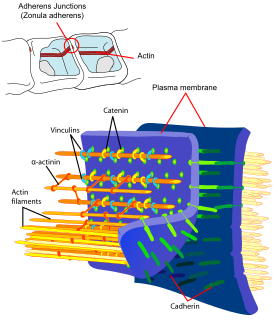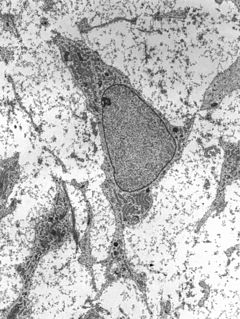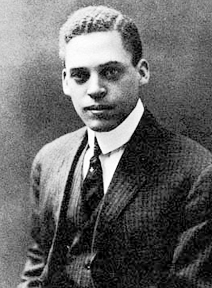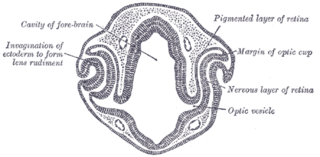Related Research Articles

Integrins are transmembrane receptors that facilitate cell-cell and cell-extracellular matrix (ECM) adhesion. Upon ligand binding, integrins activate signal transduction pathways that mediate cellular signals such as regulation of the cell cycle, organization of the intracellular cytoskeleton, and movement of new receptors to the cell membrane. The presence of integrins allows rapid and flexible responses to events at the cell surface.
Morphogenesis is the biological process that causes a cell, tissue or organism to develop its shape. It is one of three fundamental aspects of developmental biology along with the control of tissue growth and patterning of cellular differentiation.

Cell adhesion is the process by which cells interact and attach to neighbouring cells through specialised molecules of the cell surface. This process can occur either through direct contact between cell surfaces such as cell junctions or indirect interaction, where cells attach to surrounding extracellular matrix, a gel-like structure containing molecules released by cells into spaces between them. Cells adhesion occurs from the interactions between cell-adhesion molecules (CAMs), transmembrane proteins located on the cell surface. Cell adhesion links cells in different ways and can be involved in signal transduction for cells to detect and respond to changes in the surroundings. Other cellular processes regulated by cell adhesion include cell migration and tissue development in multicellular organisms. Alterations in cell adhesion can disrupt important cellular processes and lead to a variety of diseases, including cancer and arthritis. Cell adhesion is also essential for infectious organisms, such as bacteria or viruses, to cause diseases.

Adhesion is the tendency of dissimilar particles or surfaces to cling to one another.

Cadherins (named for "calcium-dependent adhesion") are a type of cell adhesion molecule (CAM) that are important in the formation of adherens junctions to bind cells with each other. Cadherins are a class of type-1 transmembrane proteins, and they are dependent on calcium (Ca2+) ions to function, hence their name. Cell-cell adhesion is mediated by extracellular cadherin domains, whereas the intracellular cytoplasmic tail associates with numerous adaptors and signaling proteins, collectively referred as the cadherin adhesome.

A morphogen is a substance whose non-uniform distribution governs the pattern of tissue development in the process of morphogenesis or pattern formation, one of the core processes of developmental biology, establishing positions of the various specialized cell types within a tissue. More specifically, a morphogen is a signaling molecule that acts directly on cells to produce specific cellular responses depending on its local concentration.

Nanofibers are fibers with diameters in the nanometer range. Nanofibers can be generated from different polymers and hence have different physical properties and application potentials. Examples of natural polymers include collagen, cellulose, silk fibroin, keratin, gelatin and polysaccharides such as chitosan and alginate. Examples of synthetic polymers include poly(lactic acid) (PLA), polycaprolactone (PCL), polyurethane (PU), poly(lactic-co-glycolic acid) (PLGA), poly(3-hydroxybutyrate-co-3-hydroxyvalerate) (PHBV), and poly(ethylene-co-vinylacetate) (PEVA). Polymer chains are connected via covalent bonds. The diameters of nanofibers depend on the type of polymer used and the method of production. All polymer nanofibers are unique for their large surface area-to-volume ratio, high porosity, appreciable mechanical strength, and flexibility in functionalization compared to their microfiber counterparts.
Compartments can be simply defined as separate, different, adjacent cell populations, which upon juxtaposition, create a lineage boundary. This boundary prevents cell movement from cells from different lineages across this barrier, restricting them to their compartment. Subdivisions are established by morphogen gradients and maintained by local cell-cell interactions, providing functional units with domains of different regulatory genes, which give rise to distinct fates. Compartment boundaries are found across species. In the hindbrain of vertebrate embryos, rhobomeres are compartments of common lineage outlined by expression of Hox genes. In invertebrates, the wing imaginal disc of Drosophila provides an excellent model for the study of compartments. Although other tissues, such as the abdomen, and even other imaginal discs are compartmentalized, much of our understanding of key concepts and molecular mechanisms involved in compartment boundaries has been derived from experimentation in the wing disc of the fruit fly.

Mesenchyme is a type of loosely organised animal embryonic connective tissue of undifferentiated cells that gives rise to blood and lymph vessels, bone, and muscle.

Ernest Everett Just was a pioneering African-American biologist, academic and science writer. Just's primary legacy is his recognition of the fundamental role of the cell surface in the development of organisms. In his work within marine biology, cytology and parthenogenesis, he advocated the study of whole cells under normal conditions, rather than simply breaking them apart in a laboratory setting.

Eye formation in the human embryo begins at approximately three weeks into embryonic development and continues through the tenth week. Cells from both the mesodermal and the ectodermal tissues contribute to the formation of the eye. Specifically, the eye is derived from the neuroepithelium, surface ectoderm, and the extracellular mesenchyme which consists of both the neural crest and mesoderm.
In computational biology, a Cellular Potts model is a computational model of cells and tissues. It is used to simulate individual and collective cell behavior, tissue morphogenesis and cancer development. CPM describes cells as deformable objects with a certain volume, that can adhere to each other and to the medium in which they live. The formalism can be extended to include cell behaviours such as cell migration, growth and division, and cell signalling. The first CPM was proposed for the simulation of cell sorting by François Graner and James Glazier as a modification of a large-Q Potts model. CPM was then popularized by Paulien Hogeweg for studying morphogenesis. Although the model was developed to describe biological cells, it can also be used to model individual parts of a biological cell, or even regions of fluid.

Leukocyte extravasation is the movement of leukocytes out of the circulatory system and towards the site of tissue damage or infection. This process forms part of the innate immune response, involving the recruitment of non-specific leukocytes. Monocytes also use this process in the absence of infection or tissue damage during their development into macrophages.

Biomaterials are materials that are used in contact with biological systems. Biocompatibility and applicability of surface modification with current uses of metallic, polymeric and ceramic biomaterials allow alteration of properties to enhance performance in a biological environment while retaining bulk properties of the desired device.
Malcolm Saul Steinberg was an American biologist who proposed the differential adhesion hypothesis as a mechanism explaining cell sorting during embryogenesis and cancer.
Biomaterials exhibit various degrees of compatibility with the harsh environment within a living organism. They need to be nonreactive chemically and physically with the body, as well as integrate when deposited into tissue. The extent of compatibility varies based on the application and material required. Often modifications to the surface of a biomaterial system are required to maximize performance. The surface can be modified in many ways, including plasma modification and applying coatings to the substrate. Surface modifications can be used to affect surface energy, adhesion, biocompatibility, chemical inertness, lubricity, sterility, asepsis, thrombogenicity, susceptibility to corrosion, degradation, and hydrophilicity.
Icephobicity is the ability of a solid surface to repel ice or prevent ice formation due to a certain topographical structure of the surface. The word “icephobic” was used for the first time at least in 1950; however, the progress in micropatterned surfaces resulted in growing interest towards icephobicity since the 2000s.
Mitotic cell rounding is a shape change that occurs in most animal cells that undergo mitosis. Cells abandon the spread or elongated shape characteristic of interphase and contract into a spherical morphology during mitosis. The phenomena is seen both in artificial cultures in vitro and naturally forming tissue in vivo.
Philip Leonard Townes was an American physician, human geneticist, embryologist and developmental biologist who identified Townes-Brocks syndrome in 1972 while a Professor of Pediatrics at the University of Rochester.
Mary Lisa Manning is an American physicist and the William R. Kenan, Jr., Professor of Physics at Syracuse University in Syracuse, New York, United States. Manning's research focuses on the behavior of glassy materials, using simulations and theory to model the emergent properties of biological tissues.
References
- ↑ Foty, Ramsey A.; Steinberg, Malcolm S. (1 February 2005). "The differential adhesion hypothesis: a direct evaluation". Developmental Biology. 278 (1): 255–263. doi: 10.1016/j.ydbio.2004.11.012 . PMID 15649477.
- ↑ Duguay, Duke; Foty, Ramsey A.; Steinberg, Malcolm S. (15 January 2003). "Cadherin-mediated cell adhesion and tissue segregation: qualitative and quantitative determinants". Developmental Biology. 253 (2): 309–323. doi: 10.1016/S0012-1606(02)00016-7 . PMID 12645933.
- 1 2 3 4 5 6 Steinberg, Malcolm S. (15 December 1996). "Adhesion in Development: An Historical Overview". Developmental Biology. 180 (2): 377–388. doi: 10.1006/dbio.1996.0312 . PMID 8954711.
- 1 2 3 4 5 6 Steinberg, Malcolm S. (August 2007). "Differential adhesion in morphogenesis: a modern view". Current Opinion in Genetics & Development. 17 (4): 281–286. doi:10.1016/j.gde.2007.05.002. PMID 17624758.
- ↑ Forgacs, Gabor; Foty, Ramsey A.; Shafrir, Yinon; Steinberg, Malcolm S. (May 1998). "Viscoelastic Properties of Living Embryonic Tissues: a Quantitative Study". Biophysical Journal. 74 (5): 2227–2234. Bibcode:1998BpJ....74.2227F. doi:10.1016/S0006-3495(98)77932-9. PMC 1299566 . PMID 9591650.